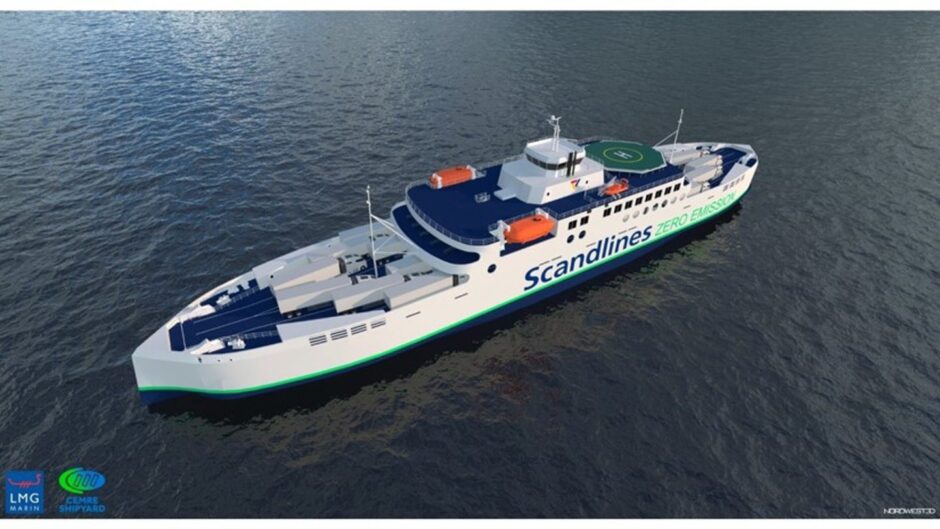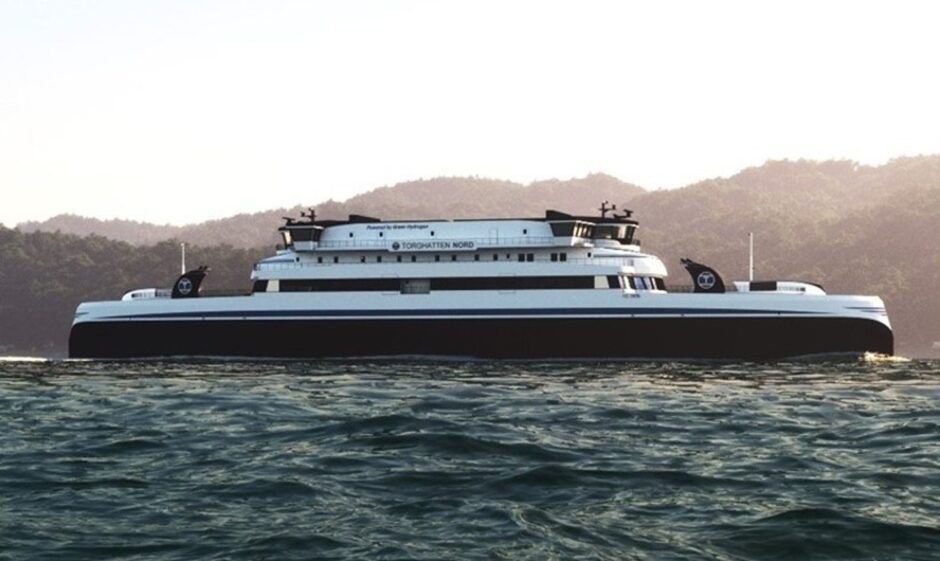
Norway has yet again demonstrated that it really is a maritime technology leader with ferry company Torghatten Nord placing an order in-country for the construction of the largest hydrogen-fuel cell ships attempted anywhere.
Delivery is scheduled for 2026.
Torghatten has placed its order with Myklebust Verft at Gursken south of Ålesund. This yard is especially well known in the North European commercial fishing industry for building among the finest pelagic super-trawlers in the world.
These are not modest roll-on roll-off ferries; they have been designed by the Norwegian Ship Design Company and will measure 117m in length overall, operate at 17 knots and be capable of carrying up to 120 cars.
They will, when completed, ply Norway’s longest ferry and arguably most challenging route of all. Namely between Bodø and the fabled Lofoten Islands north of the Arctic Circle.
Marius Hansen, CEO of Torghatten Nord said in a statement: “Together with the authorities, we are in the process of setting the standard for a completely new class of ships, with a world-class innovation and climate project.
“At Myklebust, we found an environment with high competence at a sustainable price. I am proud that we have achieved this in Norway, because this is a major boost for the Norwegian technology and shipbuilding community.”
Leiv Sindre Muren, CEO of Myklebust Verft replied: “We are very pleased to have reached an agreement to build the world’s largest hydrogen ships.
“Together with the maritime cluster in Norway, we will develop new knowledge, secure jobs and be able to take on more apprentices with this assignment.
“It will be exciting to deliver something no one has done before us.”
Quite simply, there are no other maritime hydrogen projects internationally that come close to the scale and ambitions of this project.
The suppliers of design, technology, equipment and hydrogen in the project are Norwegian, and the project is also working closely with the Norwegian Maritime Authority and the classification society Lloyd’s Register to develop procedures and safety standards for a completely new type of ferries.
A hydrogen storage unit on board the vessel will feed gas to the fuel cells, creating electricity to propel the vessels and power their auxiliary systems, reducing CO2 emissions on the route by around 26,500 tonnes annually. There will be a bio-fuelled diesel-electric backup.
The hydrogen plant will be located at Bodø and operated by GreenH. The port is a key strategic hub in the Salten region of Norway and, according to the firm, the diversity of industrial consumers makes the town a natural hydrogen production centre.
Bodø has ferries and shipping companies, big land-based transport companies with regional warehouses, the most central airport in Nordland, and the terminus of the Nordland railway.
This is not the only innovation by Torghatten Nord. On December 6, the company’s brand new 117m electric ferry, MF Hinnøy, was launched from the Cemre shipyard in Turkey.
Hinnøy will join Northern Norway’s busiest connection, Bognes-Lødingen. It too has a 120 car capacity while passenger capacity is 399.
Also developed by the Norwegian Ship Design, the double-ender – it has the design designation NSD120CFc, – will normally operate as a zero emissions vessel in exposed waters on the entire one hour transit of the Bognes – Lødingen route at a speed of 13-14 knots.
The transit time (and speed) sets a new record among the growing fleet of Norwegian battery/hybrid ferries of which there are some 80 now operating.
In addition to significant savings in CO2 emissions, Hinnøy is expected to offer greater comfort, more space and universal design.
The connection will also be a milestone for electric ferries, with a charging power of 9,200,000 watts which, as far as is known, sets a new world record in charging power on ferries.
The vessel will normally operate battery-electric with all power originating from the grid onshore through high-capacity automated charging connections.
Cemre has built a number of ferries and energy support ships to Norwegian account. The yard is also building four conventional diesel-fuelled ferries for Scottish company CMAL whose operating arm is CalMac. All are currently ahead of or on schedule for delivery.
To round off, Cemre is also constructing another ground-breaking ferry to Nordic account, this time for Scandlines’ new Futura, billed as the “world’s largest zero-emission freight ferry” and another demonstration of how the shipping industry is seeking to break free of reliance on Big Oil for fuelling.
The 147m shuttle will service the busy Puttgarden in Germany and Rødby in Denmark route and has a designed capacity of 66 freight units, which is 23% higher than current vessels serving the route.
Thanks to its novel design, it will be possible to transport lorries on both the upper and lower decks. Moreover, the modular construction of the vessel means it will be possible to later reconfigure its layout to carry cars as well.
Thanks to the hybrid diesel/battery (10MWh) electric propulsion, Futural will have the capability to feature in two different modes as fully electrical relying on plug-in battery power at 10 knots or plug-in hybrid mode at 16 knots.
The design is also prepared for future upgrades to methanol-fuelled ICE (diesel engine) propulsion.
Recommended for you

 © Supplied by Scandlines
© Supplied by Scandlines